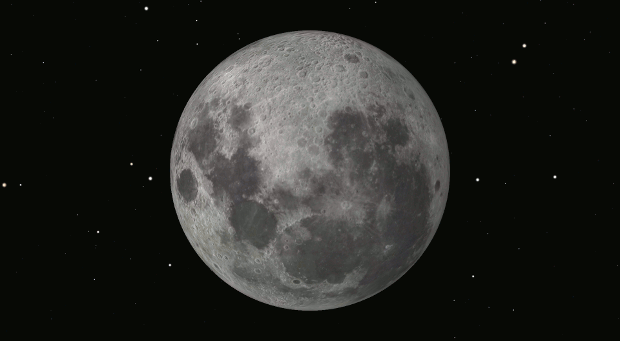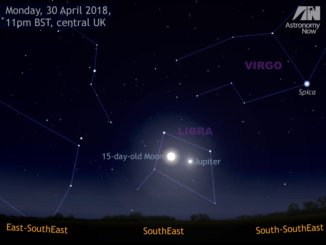Links to live eclipse webcasts may be found at the bottom of this article.
A morning eclipse for the Americas
While the Moon is below the horizon at mid-eclipse for observers in the UK, if we head west to the Americas then the eclipse occurs in the morning before moonset — and the further west you live, the better your chances are for seeing more of it. For observers around the longitude of the Great Lakes and anywhere south, the Full Moon sets while entering the densest part of the Earth’s shadow (the umbra). The Moon sets during totality for the Midwestern United States and Gulf of Mexico, while California, Oregon and British Columbia manage to see the Moon emerge from the umbral shadow before moonset. Alaska will see the entire eclipse.
Midnight in Australasia
New Zealand is perfectly situated to see the total lunar eclipse in its entirety. So too are eastern Australia, Papua New Guinea, most of Japan and the extreme west of Russia.
 For New Zealand, the Moon makes first contact with the Earth’s umbral shadow at 11:16 pm NZDT on 4th April. By NZ midnight (8:30 pm in Darwin; 7 pm in Perth; 10 pm in Sydney — all on April 4th in Australia), the almost Full Moon will be half immersed in the Earth’s shadow and the right-hand lunar limb should have a gorgeous coppery-red hue.
For New Zealand, the Moon makes first contact with the Earth’s umbral shadow at 11:16 pm NZDT on 4th April. By NZ midnight (8:30 pm in Darwin; 7 pm in Perth; 10 pm in Sydney — all on April 4th in Australia), the almost Full Moon will be half immersed in the Earth’s shadow and the right-hand lunar limb should have a gorgeous coppery-red hue.
 Totality occurs at 12:58 am NZDT on the 5th for Kiwis (9:28 pm in Darwin; 7:58 pm in Perth; 10:58 pm in Sydney — still April 4th in Australia) when the Moon will lie some 50 degrees above the north-northeast horizon in New Zealand. Technically, totality lasts just 4 minutes (though other official sources give 12 minutes; it all depends on the predicted diameter of the Earth’s shadow) since the Moon is passing through the extreme northern part of the Earth’s umbral shadow, so for those in the Southern Hemisphere the lower limb of the Moon will seem bright even at mid-eclipse.
Totality occurs at 12:58 am NZDT on the 5th for Kiwis (9:28 pm in Darwin; 7:58 pm in Perth; 10:58 pm in Sydney — still April 4th in Australia) when the Moon will lie some 50 degrees above the north-northeast horizon in New Zealand. Technically, totality lasts just 4 minutes (though other official sources give 12 minutes; it all depends on the predicted diameter of the Earth’s shadow) since the Moon is passing through the extreme northern part of the Earth’s umbral shadow, so for those in the Southern Hemisphere the lower limb of the Moon will seem bright even at mid-eclipse.
 At 2 am NZDT in New Zealand (10:30 pm in Darwin; 9 pm in Perth; midnight in Sydney) the Moon is half out of the densest part of the Earth’s shadow, and by 2:45 am NZDT the umbral stages of this eclipse are over.
At 2 am NZDT in New Zealand (10:30 pm in Darwin; 9 pm in Perth; midnight in Sydney) the Moon is half out of the densest part of the Earth’s shadow, and by 2:45 am NZDT the umbral stages of this eclipse are over.
An evening eclipse for Asia
For the longitude of Mongolia, central China, Thailand and Singapore, the Moon rises while entering the umbral stage of the eclipse. In central Russia, western China, Bhutan and Bangladesh the Full Moon rises during totality, while the longitude of India sees the Moon rise as it leaves the Earth’s umbral shadow. None of the countries of Europe will see any of this eclipse.
Watching the eclipse online
If you can’t see this lunar eclipse from where you live, don’t despair — you can watch it online! The following sources are offering live webcasts:
Slooh Community Observatory, starting at 11 am BST (10h UT)
The Virtual Telescope Project, starting at 11 am BST (10h UT)
Griffith Observatory in Los Angeles, 10 am—2:30 pm BST (9—13:30 UT)
Looking ahead to the next eclipse
For those of us living in the west of Europe, our next opportunity to view a lunar eclipse occurs on 28th September 2015. It’s a good one for the British Isles as we’ll be able to see it in its entirety — weather permitting, of course!
Inside the magazine
You can find out more about the total lunar eclipse in the April edition of Astronomy Now in addition to a full observing guide to the night sky.
Never miss an issue by subscribing to the UK’s biggest astronomy magazine. Also available for iPad/iPhone and Android devices.




